Large mobile gantry cranes are a fairly common sight at ports and container yards, but they also fulfill transportation and stacking needs in warehouses, assembly lines, and on construction sites. A crane’s capacity can vary from a half-ton to over a thousand tons. Here we’ll offer an overview of the types of mobile gantry cranes on the market, as well as some of the key characteristics you should consider before purchasing.
Table of Contents
An overview of the mobile gantry crane market
What are mobile gantry cranes
Types and capacities of mobile gantry cranes
Summary
An overview of the mobile gantry crane market
The global mobile gantry crane market is projected to grow at a healthy compound annual growth rate (CAGR) of 4.5% from USD 1.5 billion in 2022 to USD 38 billion by 2032.
The smaller gantry crane sector, defined as cranes that can lift from around 1 to 10 tons, is largely being driven by construction, manufacturing, and especially by the growth of ecommerce logistics and warehousing. These cranes are used for moving goods around warehouses, assembly lines, and goods yards.
Larger capacity gantry cranes, those that can lift upwards of 10 tons to thousands of tons, growth is being generated by heavy manufacturing, containering, shipping, and construction. The growth in construction is fueling a need to move concrete and other construction materials.
The boom in global trade post-pandemic has seen a rise in container movement for shipping, into and out of ports. As a result, the shipping industry is also investing in better infrastructure and more efficient goods movement via ports, which includes upgrading gantry cranes.
What are mobile gantry cranes
Mobile gantry cranes use a “gantry” structure straddle the containers or objects that they require moving. These free-standing cranes feature two side supports and a cross beam, or girder, for lighter capacity and two cross beams for larger capacity gantries. Side support is usually provided via an A-frame shape and can feature different types of bracing (strengthening) types for the cross beam.
The cross beam is usually referred to as a runway, as it holds the block and hook and allows for movement along the runway track, which it runs along on small wheels.
A gantry’s height is measured from the underside of the runway, while overall clearance height is measured from the top of the structure. Some smaller cranes have adjustable height via a manual or hydraulic winch.
The actual width is measured to the extreme sides of the support and any additional protruding braces, and the effective clearance is measured within the supports and any internal braces. The gantry will usually have either external or internal braces, or no braces at all.
For smaller gantries, the side supports are typically fitted with wheels, or castors, allowing mobility. Some smaller gantry structures may have a fixed mounting with feet instead of wheels, which require assembly and disassembly. Larger gantries, meanwhile, come with large-wheeled axle assemblies or rail wheels and are operated electrically.
Types and capacities of mobile gantry cranes
Mobile gantry cranes come in all sizes and capacities, from small-sized cranes with 0.5-1 ton lifting abilities to more heavy-duty gantry structures for large-scale industrial use in the 10-100 ton range. Then there are giants that can lift upwards of a thousand tons. Unsurprisingly, the structure of these cranes differs as size and capacity increase, as does their complexity and functionality. This section looks at the four main types of mobile gantry cranes available as designated by size:, small, medium, large, and giant.
Small-capacity cranes
At the lower end of the mobile gantry crane market are small-framed cranes that handle weights up to around 1-2 tons.
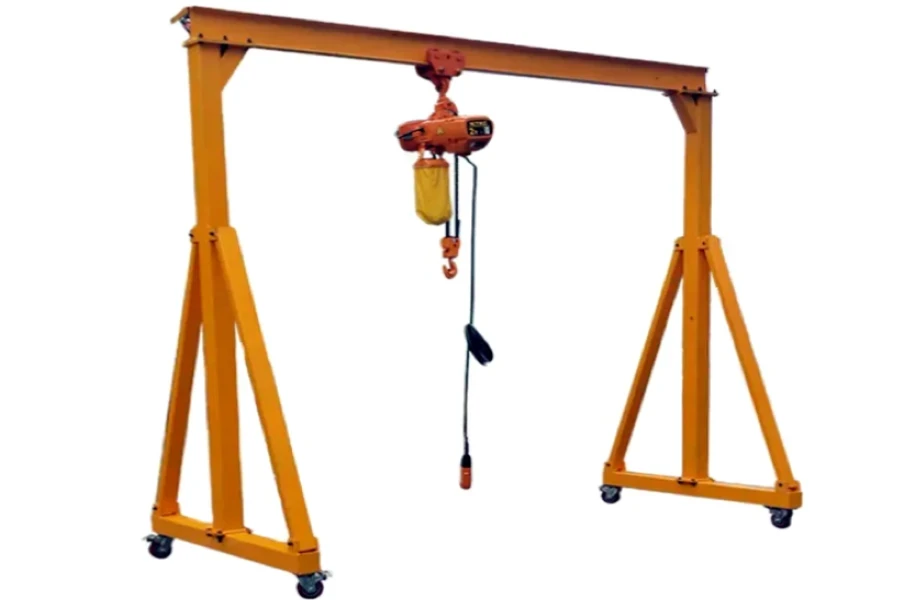
These small capacity cranes, as depicted above, usually have A-frame side supports, a single beam with internal bracing, and small wheels/castors. Note that when the weight of the load is close to maximum capacity, the wheels may become a weak point in sustaining the weight.
The block and hook have an electrical powered handset to move the block along the runway frame, and to raise and lower any attached load. The gantry frame itself has no power and is moved manually. These models are available for around USD 1,000.
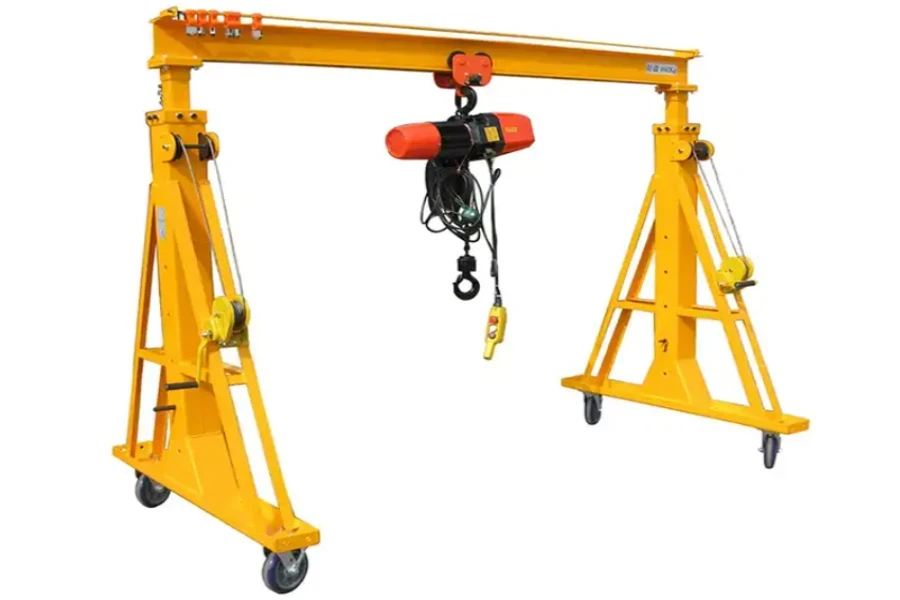
The small gantry crane above has A-frame side supports and an electric-powered block and hook with handheld control. On this model, the height of the crossbeam runway can be raised or lowered manually and the winching mechanism can be seen on the A-frames. There is no internal or external bracing. This version has up to a 1-ton capacity and is available for around USD 1,000.
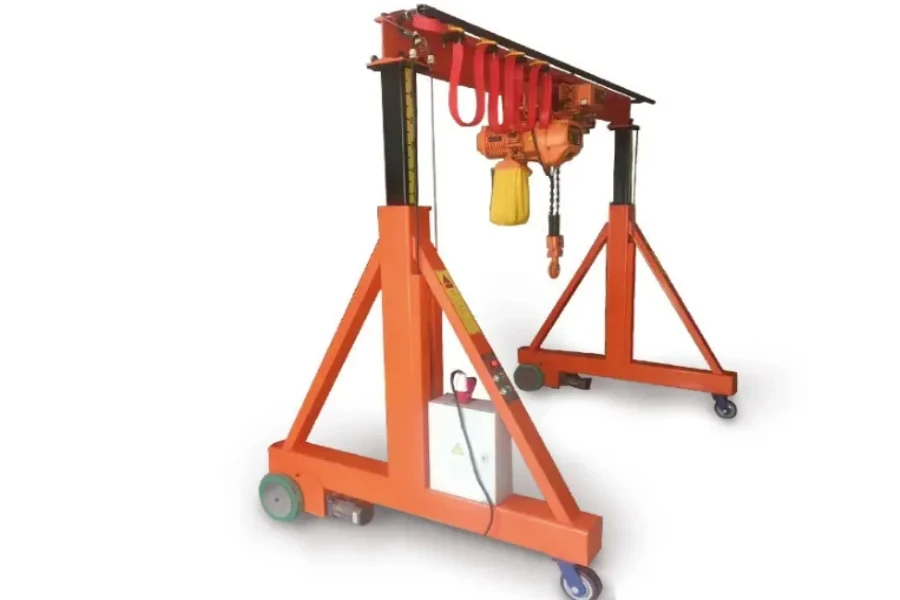
This model has an adjustable height, and has an electric winch for the block and hook, and also an electric motor to drive one set of wheels to move the gantry. Pricing varies from between USD 550 and USD 2,380 depending on the chosen size and capacity.
Medium-capacity cranes (5-10 ton)
Medium-capacity gantry cranes are often used in warehousing and manufacturing, and are a great asset on assembly lines such as automotive assembly.
The above 5-ton gantry ‘traveling’ crane uses a track to move in straight lines and lift and stack objects within the installed warehouse space. The crane uses an electric hoist and a separate electric motor for movement, allowing for speeds of up to 20 meters per minute. Gantry cranes of this capacity are usually single-girder as that is sufficient to carry these weight capacities. This model sells for USD 16,800.
This large gantry crane is used for lifting and moving large materials around a construction site, and has a 10-ton capacity with a double girder runway structure. Cranes of this size cannot be moved manually and use “walking” mechanical movement systems instead. Cranes of this type are referred to as rubber tired gantry (RTG) cranes.
Larger-capacity cranes (20-100 ton)
Large-size cranes can lift loads in the 20-100 ton range. These include container lifters and may be found in shipyards and in large factories.
This rubber-tired single girder gantry crane has a 25-ton lifting capacity, as well as a complete operating cabin and full remote-control functionality. This version sells for USD 8,000 and is used for moving heavy marble and concrete around a production factory.
This 60-ton mobile gantry crane is used to move and stack shipping containers, and can lift and stack to a 12-meter height. This model is a RTG rather than rail-mounted, which are more common for such usage. It sells for USD 72,500.
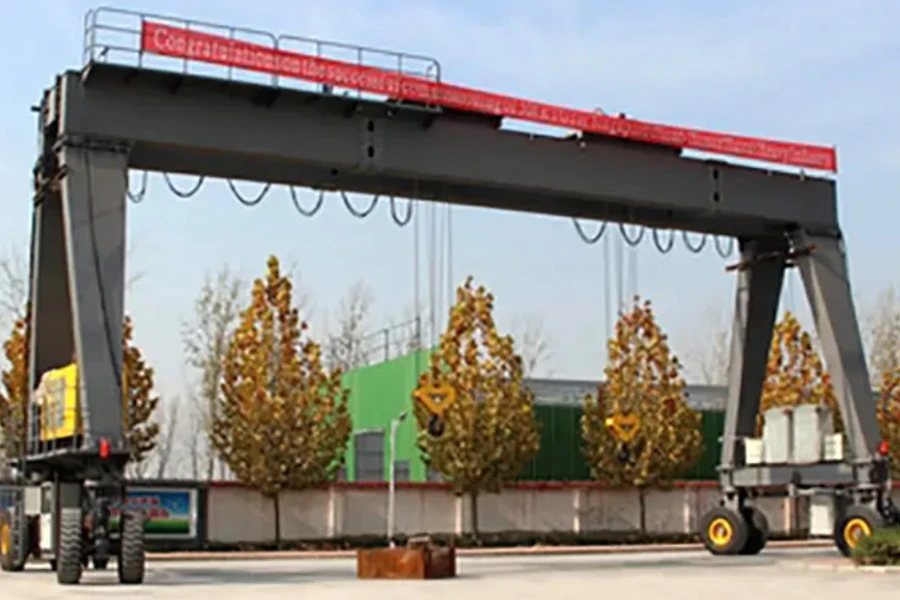
This double girder gantry crane has a capacity of 60-80 tons, selling for around USD 50,000. It has wheels that can rotate by 90 degrees, giving a wide range of movement flexibility, and is powered by an electro-hydraulic motor.
Giant mobile gantry cranes
At the top end of the mobile gantry crane range are massive gantries that lift enormous weights. These giant cranes come in different designs, with differing structures. They are often used for shipping and are usually rail-mounted, but massive wheeled versions are also available.
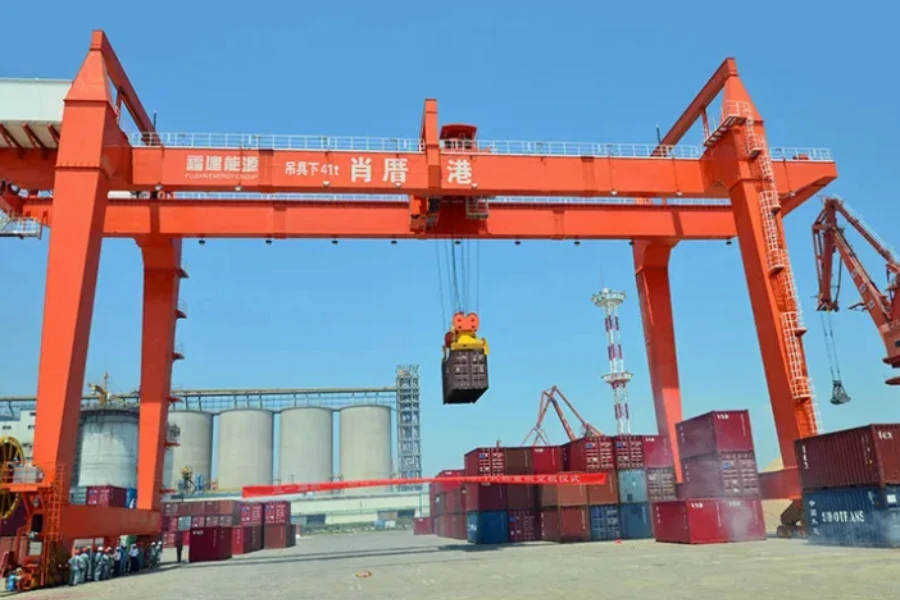
This 400-ton gantry crane, available for USD 47,000, is used to lift and stack shipping containers. Cranes of this size are usually defined as rail-mounted gantries (RMG), and are often used around shipping yards.
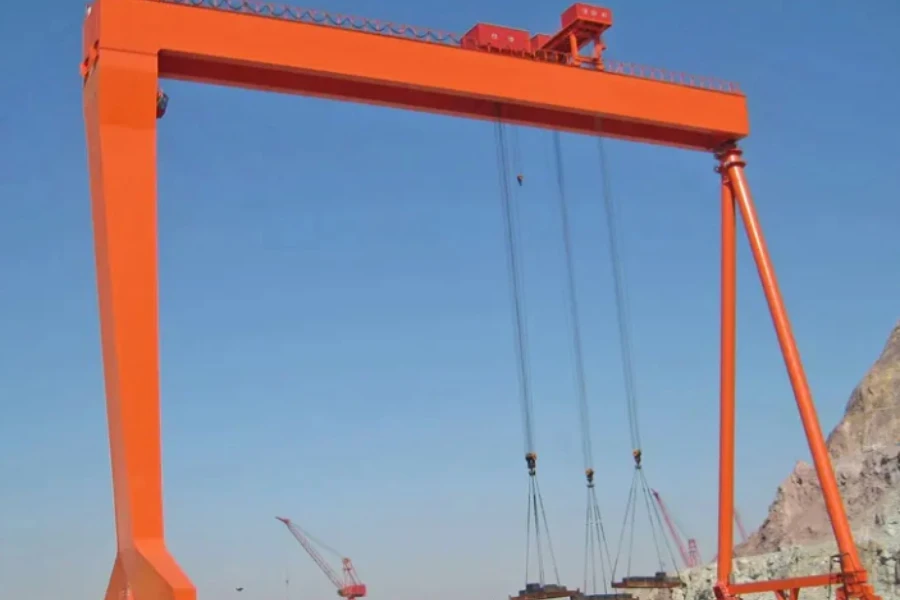
This 600-ton gantry crane is used for shipping, and has a single box pillar on one side and an A-frame on the other. The gantry has a single girder but a very large box structure version. The crane stands particularly high and can lift objects up to 60 meters. The crane sells at USD 58,000.
This 900-ton capacity crane can lift whole concrete road sections. The crane has a double girder structure, with four giant support arms that each hold eight double-wheeled axles, driven from a control platform on top of the gantry. This monster gantry sells for USD 2.9 million.
Summary
There is quite a wide range of mobile gantry cranes out there, and while the principle designs are similar – two supporting sides and then either a single or double girder as a cross beam, forming a runway to hold the boom and hooks to lift and move the load – their capacity, size, structure, and functionality can vary significantly.
A potential buyer will have a specific usage and market in mind, which will in turn inform them of the types of models and prices to consider. No matter what your needs, you’ll be sure to find exactly what you want via the huge selection of gantry cranes and other loading equipment on Alibaba.com.




